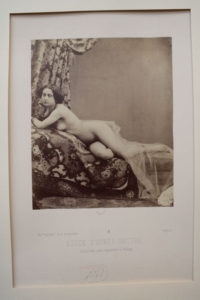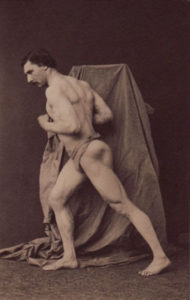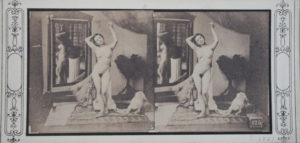By Raisa Rexer (Guest Contributor)
As anyone who has strolled the Seine in Paris has undoubtedly discovered for themselves, part of the charm of the Parisian booksellers, or bouquinistes, that line its banks (already described by Rachel Mesch on this very blog) is the fact that they are not necessarily purveyors of good taste. I am not simply referring to the overpriced reprints of Doors concert posters from the 1970s or the tacky plastic souvenirs hawked to tourists alongside gems of 19th century publishing; they also sell wares of a decidedly naughtier—but equally historically important—kind. Many bouquinistes have been known to display an ample collections of “French Postcards,” titillating vintage photo postcards of scantily clad women that made “French” a synonym for “sexy” in the early twentieth century and that remain popular with tourists today. Reprints that date to the 1920s, these postcards have a frisson of worldly sexiness tempered with the charm of a bygone and (supposedly) more innocent era, when a Parisian woman in a slip and stockings was as exciting as things got.

An “académie” from the 1850s by Félix Jacques Antoine Moulin
But as the very same bouquinistes could have shown us if we were perusing their wares some 150 years ago, those halcyon days of sepia-toned innocence never existed. The “French Postcards” of the 1920s are just one part of a long and complicated history of nude photographic imagery in France. Louis-Jacques-Mandé Daguerre took the first photograph using the process that would later come to be known by his name in 1837, and two years later the French government patented the daguerréotype process for public use. From that point on, photography’s popularity exploded in France and around the world, a popularity that quickly included the nude. In the late 1840s, some of the great photographers of the day, like Félix Moulin, Gustave Le Gray and Charles Nègre, were already experimenting with the nude. Many of these images were not only works of art, they were even approved for sale by the government. Under the strict censorship system of the Second Empire (1851-1870), any written or visual materials sold in France had to be pre-approved by the government. In the 1850s and 1860s, thousands of académies, the term used for artistic nude studies meant to stand on their own or to be used by painters and sculptors in their work, were eventually approved for sale. Courbet, Delacroix, and Gérôme worked from specially commissioned photographic académies; images that were not private commissions were sold at the École des Beaux Arts and at print and photography shops around the city.
Not all of the images approved by the government, however, had such lofty artistic aspirations. Profiting from vague censorship standards and popular demand, photographers also submitted many images featuring scantily clad women. These small-scale (and usually stereoscopic) images included portraits of actresses and society figures baring shoulders or stocking-clad legs, as well as more racy “genre scenes” of women lolling around in their petticoats while exposing

Lamie et Augé, 1860s
breasts or thighs.

Léotard by Pesme, 1860
In 1860, the great scandals of the year were a pair of portraits: one of the can-can dancer Rigolboche, in which (in the words of the Goncourt brothers) she “showed her legs in all their positions” and a half-naked picture of the male acrobat Léotard in his underwear that was making women across Paris swoon. These racier images often received conditional authorization and usually could not be publicly displayed, but they could nevertheless be sold legally from behind the counter of a photography or print shop, just like académies.
The more brazen photographers went even further, forgoing authorization at all and photographing women and couples in various states of undress and sexual activity. The first obscenity prosecution for pornography took place in 1851; by the 1850s and 1860s, these explicitly pornographic of photos could be found all over Paris. Street peddlers of everything from umbrellas to toiletries hawked them across the city as a more lucrative clandestine side business. They were sold in ever-increasing quantities in wine shops and on cafe terraces, in outdoor markets and in the back rooms of photography and print shops, and (of course) by the bouqinistes along the Seine.

A legal image from Louis Camille D’Olivier, 1860s
In October of 1860, a police raid on the home of the photographer Auguste Belloc, who was possibly the most explicit and prolific pornographer of the Second Empire, turned up over 4,000 prints and negatives, including many that would make the proverbial sailor blush. With the fall of the Empire in 1870, the relaxation of censorship laws, further technological advances in the 1870s and 1880s, and the growth of an international industry that crossed European boundaries and exploited conflicting laws to avoid prosecution, the number of photographs increased dramatically. When he was arrested in Paris in 1892, a photographer operating under the pseudonym “Léar” had managed to distribute some 800,000 obscene photographs in under three years. It is entirely possible that some two to four million nude photographs were in circulation by the end of the nineteenth century, many of them graphically pornographic and not actually produced in France at all.
The charmingly retro “French postcard,” it turns out, was tame even for its time. In fact, it was tame even for half a century before its time. It is a relic of a past that didn’t actually exist, which explains its appeal and makes it, despite its veneer of eroticism, just like any old kitschy souvenir that packages an experience of a place through stereotype rather than reality. On the other hand, the bouquinistes are just doing the same thing that has always been done. If they did start selling historically accurate nude photographs from the 1860s, they might very quickly find themselves fined or locked up. Better that they stick to their postcards.
Raisa Rexer received her PhD in French from Yale University, where her research focused on the early history of the French photographic nude and its relationship to literary representation in the nineteenth century. She is a freelance art critic and instructor of French at Yeshiva University and City College, CUNY.
Bric-a-brac-o-mania is a monthly column  on nineteenth-century literary, visual, and material culture edited by Rachel Mesch.
on nineteenth-century literary, visual, and material culture edited by Rachel Mesch.
